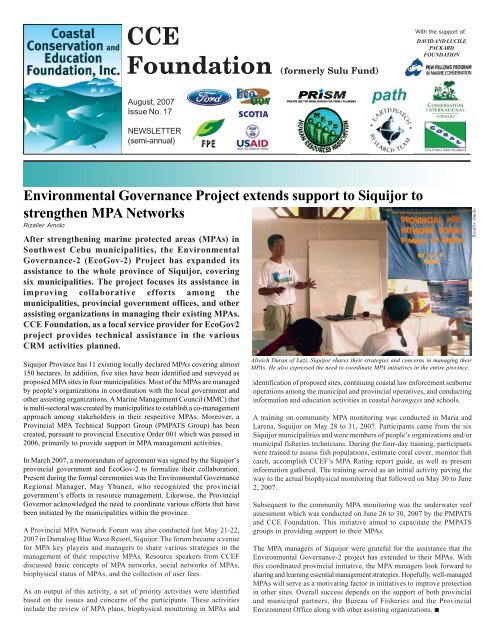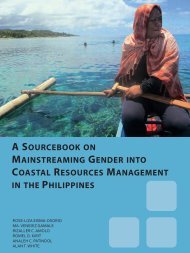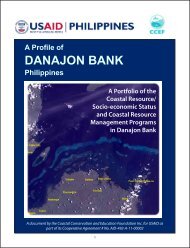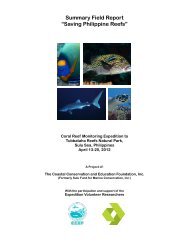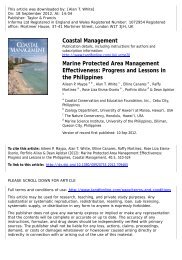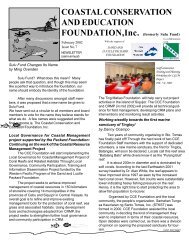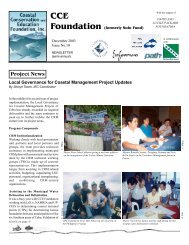Environmental Governance Project extends support to Siquijor to ...
Environmental Governance Project extends support to Siquijor to ...
Environmental Governance Project extends support to Siquijor to ...
Create successful ePaper yourself
Turn your PDF publications into a flip-book with our unique Google optimized e-Paper software.
CCEFoundation (formerly Sulu Fund)With the <strong>support</strong> of:DAVID AND LUCILEPACKARDFOUNDATIONAugust, 2007Issue No. 17NEWSLETTER(semi-annual)<strong>Environmental</strong> <strong>Governance</strong> <strong>Project</strong> <strong>extends</strong> <strong>support</strong> <strong>to</strong> <strong>Siquijor</strong> <strong>to</strong>strengthen MPA NetworksRizaller AmoloAfter strengthening marine protected areas (MPAs) inSouthwest Cebu municipalities, the <strong>Environmental</strong><strong>Governance</strong>-2 (EcoGov-2) <strong>Project</strong> has expanded itsassistance <strong>to</strong> the whole province of <strong>Siquijor</strong>, coveringsix municipalities. The project focuses its assistance inimproving collaborative efforts among themunicipalities, provincial government offices, and otherassisting organizations in managing their existing MPAs.CCE Foundation, as a local service provider for EcoGov2project provides technical assistance in the variousCRM activities planned.Rizaller Amolo<strong>Siquijor</strong> Province has 11 existing locally declared MPAs covering almost150 hectares. In addition, five sites have been identified and surveyed asproposed MPA sites in four municipalities. Most of the MPAs are managedby people’s organizations in coordination with the local government andother assisting organizations. A Marine Management Council (MMC) thatis multi-sec<strong>to</strong>ral was created by municipalities <strong>to</strong> establish a co-managementapproach among stakeholders in their respective MPAs. Moreover, aProvincial MPA Technical Support Group (PMPATS Group) has beencreated, pursuant <strong>to</strong> provincial Executive Order 001 which was passed in2006, primarily <strong>to</strong> provide <strong>support</strong> in MPA management activities.In March 2007, a memorandum of agreement was signed by the <strong>Siquijor</strong>’sprovincial government and EcoGov-2 <strong>to</strong> formalize their collaboration.Present during the formal ceremonies was the <strong>Environmental</strong> <strong>Governance</strong>Regional Manager, May Ybanez, who recognized the provincialgovernment’s efforts in resource management. Likewise, the ProvincialGovernor acknowledged the need <strong>to</strong> coordinate various efforts that havebeen initiated by the municipalities within the province.A Provincial MPA Network Forum was also conducted last May 21-22,2007 in Dumahog Blue Wave Resort, <strong>Siquijor</strong>. The forum became a venuefor MPA key players and managers <strong>to</strong> share various strategies in themanagement of their respective MPAs. Resource speakers from CCEFdiscussed basic concepts of MPA networks, social networks of MPAs,biophysical status of MPAs, and the collection of user fees.As an output of this activity, a set of priority activities were identifiedbased on the issues and concerns of the participants. These activitiesinclude the review of MPA plans, biophysical moni<strong>to</strong>ring in MPAs andAlreich Duran of Lazi, <strong>Siquijor</strong> shares their strategies and concerns in managing theirMPAs. He also expressed the need <strong>to</strong> coordinate MPA initiatives in the entire province.identification of proposed sites, continuing coastal law enforcement seaborneoperations among the municipal and provincial operatives, and conductinginformation and education activities in coastal barangays and schools.A training on community MPA moni<strong>to</strong>ring was conducted in Maria andLarena, <strong>Siquijor</strong> on May 28 <strong>to</strong> 31, 2007. Participants came from the six<strong>Siquijor</strong> municipalities and were members of people’s organizations and/ormunicipal fisheries technicians. During the four-day training, participantswere trained <strong>to</strong> assess fish populations, estimate coral cover, moni<strong>to</strong>r fishcatch, accomplish CCEF’s MPA Rating report guide, as well as presentinformation gathered. The training served as an initial activity paving theway <strong>to</strong> the actual biophysical moni<strong>to</strong>ring that followed on May 30 <strong>to</strong> June2, 2007.Subsequent <strong>to</strong> the community MPA moni<strong>to</strong>ring was the underwater reefassessment which was conducted on June 26 <strong>to</strong> 30, 2007 by the PMPATSand CCE Foundation. This initiative aimed <strong>to</strong> capacitate the PMPATSgroups in providing <strong>support</strong> <strong>to</strong> their MPAs.The MPA managers of <strong>Siquijor</strong> were grateful for the assistance that the<strong>Environmental</strong> <strong>Governance</strong>-2 project has extended <strong>to</strong> their MPAs. Withthis coordinated provincial initiative, the MPA managers look forward <strong>to</strong>sharing and learning essential management strategies. Hopefully, well-managedMPAs will serve as a motivating fac<strong>to</strong>r in initiatives <strong>to</strong> improve protectionin other sites. Overall success depends on the <strong>support</strong> of both provincialand municipal partners, the Bureau of Fisheries and the ProvincialEnvironment Office along with other assisting organizations.
2EDITORIALDiversity of <strong>support</strong> and goodgovernance..........................2PROJECT NEWS<strong>Environmental</strong> <strong>Governance</strong><strong>extends</strong> <strong>support</strong>.................1MSN: A Social Networkaims <strong>to</strong> sustaining............3FPE elects CCEF asCommittee Member ........4IPOPCORM Ending .............4Batalang-Ba<strong>to</strong> MarineSanctuary...........................4SPR Expedition inBohol.................................5Prism Update: BuildingResponsible Families......5FEATURESGreenfest sa Sugbo............6Conservation Int’l <strong>Project</strong>:Establishing Partnershipsfor Coral Reef...................6<strong>Siquijor</strong> Provincial BantayDagat................................7CCE Foundation hosts PEWresearch...........................7MPA Feature...........................8Rotary Club signs MOA withCCEF....................................8CCE FOUNDATIONTIDBITSStaff Profiles.........................8New Publications................8Wishlist.................................8Edi<strong>to</strong>rs:Dr. Alan T. WhiteMrs. Evangeline WhiteAtty. Rose-Liza Eisma-OsorioLayout and Design:Mrs. Evangeline WhitePaula LozadaManaging Edi<strong>to</strong>r:Sheryll TeschDr. Alan T. WhiteEdi<strong>to</strong>rialDiversity of <strong>support</strong> and good governance are essential foreffective managementThis issue again highlights the diversity of activitiesneeded <strong>to</strong> <strong>support</strong> sustainable coastal managementprograms in the Philippines, or anywhere. Articles rangefrom environmental governance and reproductive health<strong>to</strong> progress in marine protected areas and building nationalnetworks of MPA practitioners. All these activities areessential <strong>to</strong> build long lasting and effective coastalmanagement.Nevertheless, although we are doing the right things, allis not well in some areas of our practice that offer poignantlessons. To draw from the report of the recent “SavingPhilippine Reefs” expedition <strong>to</strong> the Bohol Marine Triangle(BMT) area, we saw progress but also some distressingissues in this area where much attention has been focusedin recent years. To quote from the soon <strong>to</strong> be releasedreport:The results of our interviews with fishers, resor<strong>to</strong>pera<strong>to</strong>rs, people’s organization members, and barangayofficials regarding their perceptions documentmanagement and enforcement problems. Poachingallegedly occurs in most of the sanctuaries. In most MPAs,the lack of enforcement is perceived as a consequence ofpoor institutional <strong>support</strong> in providing honoraria <strong>to</strong>sanctuary wardens. The encroachment of commercialfishers in municipal waters continues <strong>to</strong> be a threat inBohol among others. Another important issue is the sizeand boundaries of the sanctuaries or core zones.Although all of the sanctuaries surveyed have boundariesthat <strong>to</strong>tally enclose the reef <strong>to</strong> some distance offshore, theactual boundary enforcement has wavered so that someboundaries only enclose the reef flat and not the entirereef crest and drop off where most reef fish reside. Ineffect, fishing is occurring within the intended core zonebecause of the poor placement of boundary markers.This recent development reflects a lack of strict adherence<strong>to</strong> the original municipal ordinances resulting in a wronginterpretation by the locals and <strong>to</strong>urists. As example, thesnorkeling line at the Balicasag MPA along the reef crestmay be confused by fishers as the MPA boundary andjustify their fishing on the reef slope.Data collected during the 2007 expedition compared withprevious surveys in 2003, 1997, 1995 and earlier forseveral sites showed declining trends in fish densitiesand biomass in most sites. This indicates a need <strong>to</strong>improve enforcement with stronger <strong>support</strong> from thelocal governments (LGs). To further draw from the BMT,it is recommended that:• MPA management conflicts are resolved amongmanagement groups and between stakeholdersso that MPA management groups areempowered.• Partnerships between LGs and communitygroups are strengthened and that LGs adoptthe MPA management plans developed withcommunity input.• Networking is initiated among MPAs withinthe BMT for management groups.• Simple and practical user-fee systems areimplemented with strong institutional<strong>support</strong>.• MPA boundaries are assessed and fixed <strong>to</strong>Municipal ordinance decisions.• Minimum size for all no-take sanctuaries inthe BMT is set at 10 hectares.• Education and awareness campaigns for thesanctuaries are continued.The observation that the offshore MPA boundariesenclose mostly the reef flat or crest and not the slope isworrisome because the primary benefits of the no-takesanctuary will be lost if this is the case. This isdetrimental <strong>to</strong> the fish s<strong>to</strong>cks inside the MPA since manyof the larger sizes of fish reside along the crest <strong>to</strong> slope.If the larger sizes are depleted, this will lead <strong>to</strong> a nonfunctionalMPA.Thus, we must always return <strong>to</strong> the basics of ourknowledge and experience <strong>to</strong> ensure that the quality ofour work on MPAs and other coastal management <strong>to</strong>olsis not eroded. For BMT, all is certainly not lost sinceseveral of the MPAs, namely Tawala and Balicasag, aredoing well, and the overall coral cover in most of thesanctuaries is stable or improved. Nevertheless, wecannot escape from the need for “diversity of <strong>support</strong>and good governance” <strong>to</strong> make our coastal managementsystems effective!Join or volunteer with CCE Foundation now if you want<strong>to</strong> contribute <strong>to</strong> this ongoing work on Philippine coasts!Board Members and AffiliationsPresidentDr. Alan T. White(Senior Scientist, Global Marine Initiative,The Nature Conservancy)Vice-President/TreasurerMr. William Jatulan(Deputy Chief-of-Party, Fisheries Improved for SustainableHarvest (FISH) <strong>Project</strong>)SecretaryMrs. Evangeline White(Finance Consultant, Community Conservation Network)CRM AdvisorDr. Patrick Christie(School of Marine Affairs, U. of Washing<strong>to</strong>n)Visayas AdvisorMrs. Rebecca Pestano-Smith(IEC Coordina<strong>to</strong>r, FISH <strong>Project</strong>)Community Work AdvisorMrs. Evelyn Deguit(Training Coordina<strong>to</strong>r, FISH <strong>Project</strong>)Institutional Development AdvisorDr. Thomas J. Mueller(Independant Educational Consultant)
R. Amolo<strong>Project</strong> NewsMSN: A social network aiming <strong>to</strong> sustain MPAs in thePhilippinesRizaller AmoloAfter 30 years of efforts in marine protection, thePhilippines has established over 500 marine protectedareas (MPAs), a majority are small (15ha), and officiallydeclared by municipal ordinance. However, recentstudies have shown that only 15 <strong>to</strong> 20 percent of theseare effectively managed. Among the fac<strong>to</strong>rs that affectmanagement efforts are weak governance, weak lawenforcement, lack of funds and logistical <strong>support</strong>, lackof coordination among stakeholders, absence of incentivesystems, and absence of standards for assessment andmoni<strong>to</strong>ring.It is in this light that the Marine Protected Area SupportNetwork (MSN) in the Philippines was set up. MSN isa multi-sec<strong>to</strong>ral group of government agencies, nongovernmen<strong>to</strong>rganizations, peoples’ organization andacademic institutions that have a common goal in<strong>support</strong>ing MPA initiatives through complementarycollaborative efforts at the local, regional, and nationallevel. It aims <strong>to</strong> build on the Philippine Marine SanctuaryStrategy (PhilMarSaSt) <strong>to</strong> contribute <strong>to</strong> theimprovement of MPA management effectiveness and <strong>to</strong>achieve at least 10 percent ‘full protection’ of coastalareas by the year 2020. (excerpt from P. Aliñopresentation).In 2005 a discussion among 20 organizations led <strong>to</strong> thecreation of an institutional network of MPA managers.The idea was conceptualized during various meetingsand workshops on marine protection initiatives. OnNovember 2005, a memorandum of agreement wasdrafted and an initial action plan was formulated. Majoractivities in the action plan include sourcing of funds forsustainability, organizing regional forums and adaptivemanagement training activities, formulating an award andincentive system for MPA champions, planning an MPACongress, and other relevant activities. Currently, Dr.Perry Aliño of University of the Philippine MarineScience Institute heads the Secretariat Committee ofthe network.To achieve its role as a <strong>support</strong> network for MPAmanagement, the following are the objectives of MSN:(1) Formulating an action plan that <strong>support</strong>s local andregional adaptive management activities through itsmoni<strong>to</strong>ring, evaluation, response and feedback system;(2) facilitating the establishment of incentive systemsfor improved MPA management and performance (e.g.annual recognition awards); (3) facilitating financialleveraging; and (4) advocating protection throughpolicy and legislative reforms.Various activities have been initiated <strong>to</strong> realize thenetwork’s commitment. On February 12 <strong>to</strong> 13, 2007,a regional forum for the Visayas was conducted inCebu City. Participants from Regions 4 <strong>to</strong> 8 attendedand shared their initiatives in MPA and resourcemanagement. Similar forums were conducted inMindanao and Luzon in March and April 2007. Duringthe forums there were deliberations <strong>to</strong> identify regionwideinitiatives and possible collaboration of priorityundertakings. The First Regional Training Workshopon MPAs was also conducted on June 1 <strong>to</strong> 22, 2007 inSagay City, Negros Occidental.More activities are planned and the creation of anawarding system is under way. Presently, entries arebeing screened <strong>to</strong> recognize MPA championsnationwide. Pursuing its commitment <strong>to</strong> coastalresource protection, the MSN looks forward <strong>to</strong>improved and more effective management of manyMPAs involved in this social network that linksmanagers through sustained activities that facilitatesthe sharing of experiences.Participants of the MSN Visayas Regional Forum held in DECS-Ecotech, Cebu City last February 12-13, 2007. Cluster madeup of Moalboal, Badian and Alegria.7number of CCEF boardmembers10number of LGUsassisted by CCEF2232BY THENUMBERS3number of volunteersduring the 2007 SPRExpedition <strong>to</strong> Boholnumber of staff inCCEF as of 2007number of MPAcollabora<strong>to</strong>rs30number of companiesbeing assisted byPRISM projectaverage age of CCEFstaffnumber of MPAsassisted by CCEF3391974number of MPAs inthe MPA Databaseyear CCEF wasregistered as anNGO202878206,000year Sumilon Is.Marine Reserve,the first MPA in thePhilippines, wasestablished1998number ofmangrovesplanted, <strong>to</strong> date, for theMillion Mangroves <strong>Project</strong>792,700Philippinepesoscollectedafter the first 5 months of user-feeoperation in Moalboal
4IPOPCORM <strong>Project</strong> EndingReggie SabandalTraining programs for the LGU and communities willhelp ensure the sustainability of IPOPCORM initiativesThe Integrated Population and CoastalResource Management (IPOPCORM) <strong>Project</strong>of CCE Foundation, Inc. has beenimplementing coastal resource managementand reproductive health activities in OlangoIsland and in Lapu-Lapu City since 2003, with<strong>support</strong> from the PATH Foundation,Philippines, Inc. In 2007, the Expanded-IPOPCORM project was implemented withfinding from the United Nations fund forPopulation Activities (UNFPA) throughPATH Foundation, Philippines Inc.The project envisioned the installation ofsystems for sustainability and <strong>to</strong>institutionalize strategies and initiatives inlocal government plans and programs. CCEFcontinued <strong>to</strong> implement selectedIPOPCORM-related activities (e.g. the microfinanceprogram, community-baseddistribu<strong>to</strong>r (CBD) sales inven<strong>to</strong>ry andmoni<strong>to</strong>ring) and continued technicalassistance <strong>to</strong> key leaders and organizationsin the project sites on a minimal level <strong>to</strong>sustain the project.The project phased out at the end of June,2007. However, CCEF has ensured theintegration of reproductive health (RH) withcoastal resource management (CRM) and theidentification of sustainable mechanisms inthe project areas. By using CRM as an entrypoint, the project has been able <strong>to</strong> get <strong>to</strong> thecore of the recruitment process and has alsogreatly utilized RH as a strategy <strong>to</strong> addressthe pressing concerns on fisheries. Despitethe close of the project in reproductive health,the foundation looks forward <strong>to</strong> otheropportunities available <strong>to</strong> work in the same areas<strong>to</strong> further assist them in CRM and RH needs.Currently, the World Wide Fund (WWF) andPhilippine Business for Social Progress (PBSP)are continuing their work there along similar linesof interest.CCE Foundation<strong>Project</strong> NewsFoundation for the Philippine Environment elects CCEF asRegional Advisory Committee MemberThe Regional Advisory Committee of theFoundation for the Philippine Environment(FPE) has recently nominated and elected theCoastal Conservation and EducationFoundation, represented by its ExecutiveDirec<strong>to</strong>r Atty. Rose-Liza Eisma-Osorio as oneof the 13 RAC-Visayas members.The FPE is essentially a grant-makinginstitution which was organized in 1992 <strong>to</strong>help reverse the destruction of Philippineresources through a strategic and integratedprogram. Considered as the largest Philippinenon- government, grant-making institutionfor the environment and sustainabledevelopment, FPE <strong>support</strong>s NGO initiativesin protecting the Philippine environment.Through the majority membership of itsBoard of Trustees and the participation ofthe Regional Advisory Committees (RAC),FPE’s strategic goals and integratedAfter a long wait, the Ordinance declaringthe Batalang Ba<strong>to</strong> Marine Sanctuary (BBMS)in Tingloy, Batangas, was approved in April,2007. The Batalang-Ba<strong>to</strong> ManagementCouncil (BBMC) is mandated <strong>to</strong> manageBBMS. According <strong>to</strong> Municipal Councilor,Ebet Dumaual, the ordinance is a testamen<strong>to</strong>f the local government’s sincerity inconserving and managing the waters ofTingloy. However there is still a need <strong>to</strong>formulate Implementing Rules andRegulations (IRR) of how the marinesanctuary will be managed. The IRR will bedrafted by all stakeholders such as theBBMC, Samahan Tungo sa Kaunlaran ngS<strong>to</strong>. Tomas (STKST), Local Government Unit(LGU), Municipal Agrarian Office (MAO),Sangguniang Bayan (SB), Barangay Talahiband S<strong>to</strong>. Tomas representatives, and theMunicipal Fisheries and Aquatic ResourcesManagement Council (MFARMC). The IRRwill include the rules for the user-fee systemand <strong>to</strong>urism related activities withcorresponding fees as follows:Snorkeling...........................................P 50.00Diving.................................................P 100.00Diving with camera...........................P 200.00Diving with video camera.................P 300.00Atty. Rose-Liza Eisma-Osorioconservation programs are broadlydiscussed.The RAC, which is created by the FPE Boardof Trustees outside of the regionalconsultative groups is composed of NGOs,People’s Organizations (PO) and academethroughout the country. They advise theBoard of Trustees in policy-making, programdevelopment, governance and nominationfor the incoming Board of Trustees of FPE.There is one RAC in each of the main regionsof Luzon, Visayas and Mindanao. Theregional RACs in its regular meetingsdeliberate and prioritize regionalenvironmental issues that will guide FPE inprioritizing its programs at the regional andnational levels.The new set of RAC-Visayas members areelected for a 2-year term from 2007 <strong>to</strong> 2009.Batalang-Ba<strong>to</strong> Marine Sanctuary: To Be Opened for DivingArnold Tiro and Anna MenesesThe funds collected from the fees will beused <strong>to</strong> sustain BBMC management activitiesand daily operations, repair and maintenanceof physical structures of the sanctuary, andother related expenses including theprovision of incentives <strong>to</strong> the members ofthe BBMC. The funds will be managed byBBMC and will be shared as follows:BBMC................................................. 40%Brgy. Talahib......................................15%Brgy. S<strong>to</strong>. Tomas................................15%LGU Tingloy.......................................30%The BBMS will formally open before yearend<strong>to</strong> welcome visi<strong>to</strong>rs with the objectives ofsustaining marine conservation efforts, promotingmarine ecology education, and enhancingthe recreational diving experience.BBMC, along with STKST, have faced manychallenges in sanctuary implementation beforethis point. Members have sacrificed timeand energy and struggled <strong>to</strong> keep the sanctuaryalive, year after year, and they anticipatethat their efforts will pay off with thepassing of this ordinance.
<strong>Project</strong> News2007 Saving Philippine Reefs Expedition conducted in the Bohol Marine TriangleRoxie DiazFor the fourth time since 1992, the islands in theBohol Marine Triangle (Panglao, Balicasag andPamilacan) were chosen as the sites for the SavingPhilippine Reefs expedition. This year’sexpedition (March 26-April 3) surveyed sevenestablished Marine Protected Areas (MPAs),their adjacent reefs, and the local communityclosely situated close by <strong>to</strong> <strong>to</strong> compare <strong>to</strong> datacollected (for some sites) in 1983, 1984, 1992,1999, and 2003. Data on fish abundance andspecies diversity, coral and substrate covercomposition, invertebrate population, causes ofcoral damage and community perception werecollected, analyzed and compared with theprevious information. Ten international divingvolunteers, eight of whom are regular participantsand two first timers along with eight CCEFoundation staff comprised this year’s dive team.During the entire durationof the trip, Bohol BeachClub (BBC) served as basecamp for the expedition.BBC provided the teamwith a spacious generalworking area used for dailygeneral dive briefings beforeheading <strong>to</strong> the respectivedive boats, as well as forthe nightly researchpresentations and projectupdates of CCEFoundation. BBC housedthe team comfortably, fedthem sumptuously andattended all the team needswith extra consideration.Saving Philippine Reefs 2007 participants and staff.5The project’s main objective is <strong>to</strong> collect empiricalsurvey data <strong>to</strong> be used as a management <strong>to</strong>ol <strong>to</strong>help MPA managers and local governmentexecutives formulate relevant policies and soundregulations for the security and sustainability oftheir respective locally managed MPAs. Theresults of the expedition (substrate cover, fishabundance and diversity, and socio-economicdata) will be reported back <strong>to</strong> the respective localgovernments and communities managing themarine sanctuaries located in the Bohol MarineTriangle.The Mactan Export Processing Zone – HumanResources Association (MEPZ-HRA) throughthe CCEF is implementing the project entitled“Building responsible families <strong>to</strong>wards enhancedproductivity in the workplace: Institutionalizinga family welfare program in the Mactan EconomicZone” which is <strong>support</strong>ed by the Private Sec<strong>to</strong>rMobilization for Family Health (PRISM). Theproject aims <strong>to</strong> promote the family welfareprogram in the 30 MEPZ-HRA membercompanies through various activities includingtechnical assistance and capacity building.The 30 firms include Alta Mode, Aso Philippines,A<strong>to</strong>med Cebu, Au<strong>to</strong>liv Izumi Philippines, CebuIwakami, Cebu Microelectronics, CelesticaPhilippines, Christ Philippines, Exas Philippines,Feeder Apparel, Globalwear Manufacturing,Halsangz Plating Cebu, Headway CapsInternational, Hideka Manufacturing,International Jewelry Manufacturing, KyoceraKinseki Philippines, Mactan Apparels, Mako<strong>to</strong>Metal Technology, Matluster, Metrowear,Mosaic Nine Two Five, Pan-phil Sportswear,Phil-Japan Metal & Refined Products, PhilippineLight-Leather, Philippine Mako<strong>to</strong>, SaturnBeing my first SPR trip, I was as<strong>to</strong>unded by howmeticulous the participants were with their workand how proficient they were with theirpreparations. Since most of the volunteers havebeen doing this annually over several years, theyhave become very accus<strong>to</strong>med <strong>to</strong> the dailyroutines that happen during SPR trips. I admirethe SPR volunteers who have been continuouslycontributing financially <strong>to</strong> join the trip <strong>to</strong>contribute <strong>to</strong> the research and <strong>to</strong> join CCEFoundation in its advocacy on global reefconservation.PRISM <strong>Project</strong> Update: Building Responsible FamiliesAnaleh PatindolInternational Design & Development, TriggerCompany (Philippines), Ube Electronics(Philippines), Western Wats Philippines andIntegrated Microelectronics which replaced TongFang International.To date, trainings that have been conducted are:Family Health Management Team (Batch 4), PeerEduca<strong>to</strong>rs (Batch 4), Maternal and Child HealthTraining for Nurses (Batch 2). All companieshave submitted the rapid appraisal <strong>to</strong>ol, workplacefamily planning index, and most of them haveconducted the family planning needs assessmentsurvey as part of the baseline <strong>to</strong>ols. The resultsof the FPNA survey are presented back <strong>to</strong> theemployees and the data is utilized <strong>to</strong> address theneeds for peer education work. Mako<strong>to</strong> MetalTechnology, Inc., Kyocera Kinseki Philippines,Inc., Ube Electronics (Phils.), Inc. and PhilippineMako<strong>to</strong> Corporation have initiated a series offamily planning orientations <strong>to</strong> provideinformation on the different family planningmethods available including FP services availablein their respective workplaces. Trained PeerEduca<strong>to</strong>rs with the assistance of the CompanyMy first SPR trip in Bohol was quite anexperience because I enjoyed meeting ourgenerous, hard-working international volunteerswho are willing <strong>to</strong> go an extra mile for a cause.The SPR Expedition in 2008 will be held on alive-aboard dive boat in the Tubbataha MarinePark in Cagayancillo, Palawan. I look forward <strong>to</strong>another productive trip <strong>to</strong> increase ourinformation bank and <strong>to</strong> meet with the regularvolunteers that, quite obviously, always makeeach expedition worthwhile!Nurses facilitated the training for MMTI andPMC.Companies have established a regular meetingschedule with the members of the family healthmanagement team and peer educa<strong>to</strong>rs <strong>to</strong> discussconcerns, issues encountered and plan outactivities. Surprisingly, men are actively involvedin the conduct of FP orientation whichdemonstrates a positive outcome of the trainingand information dissemination conducted. ChristPhilippines, Inc.and the Philippines Light-Leather, Inc. celebrated its 10 th year anniversaryon June 15 at the function room of the Shangrila’sMactan Resort. Games, presentations,awarding of employees (5-10 years in service)and the soft launching of the PRISM projecthighlighted the one-day event.On April 26, 2007, the MEPZ-HRA convenedfor the general membership meeting in WaterfrontMactan, with the newly installed president ofthe association, Mr. Jeoffrey R. Escala. ThePRISM <strong>Project</strong> was given the opportunity <strong>to</strong>update the member companies on the progress ofthe project implementation.
6Greenfest sa SugboMaretes Alen<strong>to</strong>nJune, being the Philippine EnvironmentMonth, Green Forum organized activities, aspart of nearly a year-long series ofenvironmental conservation activities, <strong>to</strong>enhance the awareness of the general publicon the pressing ecological issues, such asglobal climate change, pollution, andthreatened ecosystems. The Green Forum,of which CCEF is an active member, servesas a catalyst for promoting environmentfriendlypractices in collaboration withdifferent organizations and localgovernment, the Cebu City Governmentbeing the most active, so far.The Green Forum recognizes that promotingenvironmental sustainability is a MilleniumDevelopment Goal which needs <strong>to</strong> belocalized for its effective attainment. Theyhave realized that it is time for people <strong>to</strong> actnow in their environment and give a hand infixing what has been destroyed – the air, theseas, and the land. It is through activities,such as the Green Fest, that the Green Foruminvolves civil society, the private sec<strong>to</strong>r, andgovernment in addressing challengingenvironmental issues.The Greenfest sa Sugbo with the theme “OurCoasts, Our Heritage” was conducted lastJune 9-10, 2007. A portion of the FuenteOsmeña Boulevard was closed <strong>to</strong> mo<strong>to</strong>ristsin order <strong>to</strong> accommodate booths thatshowcased different environmentalinnovations and products <strong>to</strong> be screened bythe public. The booths showcased tradebooths such as solar panels, handicrafts,renewable energy, beekeeping, traditionalmassage, organic products, among others.A parallel series of lectures and orientations,promoting environmental protection, wasCCE Foundation picturesFeaturesConservation International <strong>Project</strong>:“Establishing Partnerships with Dive Professionals for CoralReef and Species Conservation”In a continuing effort <strong>to</strong> establish workingrelationships with all sec<strong>to</strong>rs involved withMarine Protected Areas (MPAs),Conservation International has recentlyapproved a CCEF proposal which will addressthe issues related <strong>to</strong> recreational divinginside MPAs.The objectives of the project are <strong>to</strong> work withdive professionals and their associated divecenters in order <strong>to</strong> conceptualize and thenproduce diver education materials (DVD,F.A.Q, Flip Charts, Posters, Billboards) thatcan be used in the classroom, on the diveboat as briefing materials and at the sanctuarylocations. The initial target areas are theVerde Passage Marine Biodiversity Corridorand Cebu Province.The basis for this tactical approach is due <strong>to</strong>the nature of why MPAs are established inthe Philippines. Many MPAs in thePhilippines were, and still are, designedprimarily <strong>to</strong> promote fisheries managementand not <strong>to</strong>urism. In spite of that, these sameMPAs allow recreational diving within theprotected area, at a specified cost, as a meansof revenue generation for sustainingsanctuary management.However, not all of these MPAs are readyfor <strong>to</strong>urism. Most do not have the capacity<strong>to</strong> regulate and moni<strong>to</strong>r diving activities anddo not have a good awareness andinformation program <strong>to</strong> disseminateregulations and policies. They sometimesEthan Lucaslack enforcement <strong>support</strong> structures such asboundary markers, moorings, and billboardsigns showing the regulations and map ofthe protected area <strong>to</strong> indicate boundaries. Inlight of these problems, it is commonlyobserved that many divers enter MPAs notknowing the difference and not knowing thereal value of these MPAs <strong>to</strong> the localcommunity working so hard <strong>to</strong> protect it. Inaddition, diving activities in MPAs continue<strong>to</strong> increase..What this project aims <strong>to</strong> do is <strong>to</strong> motivatedive institutions involved <strong>to</strong> help raiseawareness about the importance of MPAsand <strong>to</strong> promote “a diving code of conduct”.There is an aim <strong>to</strong> develop an attitudethrough education that teaches divers thatthese precious coastal resources are notmanaged <strong>to</strong> increase diving pleasure, but thatcommunities have invested great amountsof time and effort in establishing andmaintaining them for the purposes of foodand environmental security for future Filipinogenerations.As communities begin <strong>to</strong> benefit from animproved coastal ecosystem, the diveindustry will also benefit from the aestheticsof a well-maintained MPA, as well as bringknowledgeable and informed, and ultimately,responsible divers in<strong>to</strong> MPAs. Hopefully,divers will feel compelled <strong>to</strong> protect thePhilippine environment, and not <strong>to</strong> beindifferent about it as a result of thisproject.also conducted in the adjacent Department of Health (DOH)conference rooms.Participating organizations were the Cebu City Government,Barangay Sambag II, Police Regional Office 7, Department ofHealth, Bureau of Fisheries and Aquatic Resources,Department of Agriculture, Ramon Aboitiz Foundation, Inc.,University of San Carlos, Energy and Clean Air <strong>Project</strong>, CCEFoundation, Plant Oil S<strong>to</strong>ve of Leyte State University,<strong>Environmental</strong> Legal Assistance Center, Crocolandia,Sugarbuzz Productions, Mactan Grill Chain of Restaurants,Foundation of Volunteer Radio Communica<strong>to</strong>rs, CommunityChristian Fellowship, Law of Nature Foundation,Calimasada, and Ngohiong Express.CCE Foundation and FISH <strong>Project</strong> booth during the Greenfest activity promoting resource management.
Features<strong>Siquijor</strong> Provincial Bantay-Dagat: Protecting <strong>Siquijor</strong> WatersRizaller Amolo7In the course of CCE Foundation’scommitment <strong>to</strong> encouraging coastal resourcemanagement (CRM) <strong>to</strong> become a basicservice, it encounters people who are tasked<strong>to</strong> provide and committed <strong>to</strong> making CRMservices sustainable. These are people whoencourage CCEF workers <strong>to</strong> carry out itsmission. It is these people whom we call“local champions.”The <strong>Siquijor</strong> Provincial Bantay-Dagat TaskForce was created pursuant <strong>to</strong> ProvincialOffice Order No 2007-008. It is composed of18 members from the Provincial AgricultureOffice, PNP-Provincial Command, BFAR-<strong>Siquijor</strong> and PENRO. The team was createdprimarily <strong>to</strong> neutralize illegal fishing activitiesand other criminal elements within themunicipal waters of <strong>Siquijor</strong>. The team whichis led by Mr. Darell T. Pasco, is made up ofmunicipal government partners, fishwardens, and fishers. Fellow enforcersendearingly refer <strong>to</strong> him as “Papang.”Darrell and his team’s devotion <strong>to</strong> givingservice <strong>to</strong> others is their personalcommitment <strong>to</strong> the residents of <strong>Siquijor</strong>Island. The <strong>Siquijor</strong> Provincial Bantay-Dagat, received a special citation during the2006 Search for Outstanding FisheriesAchievers under the Outstanding Bantay-Dagat category. Darell Pasco also receiveda special citation as Outstanding FishWarden during the same awarding ceremony.Currently, the Provincial Bantay-Dagat andboth provincial and municipal PhilippineNational Police (PNP) members patrol themunicipal waters of the six componentmunicipalities making up <strong>Siquijor</strong> Province.Over, 50 apprehensions have been madesince 2005. Their performance has gained theconfidence and commitment <strong>to</strong> <strong>support</strong> thecause among municipal chief executives,local resource managers and partners, as wellas the Governor of <strong>Siquijor</strong> and provinciallegisla<strong>to</strong>rs.In carrying out their duties, Darrell and histeam have been through both harrowing andinspiring experiences. They have hadconfrontations, at sea and in the courtroom,with stubborn repeat viola<strong>to</strong>rs. But thesehave never hampered their momentum andinitiative.According <strong>to</strong> them, enforcement is inevitablycoupled with high risk situations. The respectand overwhelming <strong>support</strong> from theprovincial government, municipal partners,and other assisting organizations hascontributed in fueling their dedication inenforcement of fisheries laws and policies.Darrell “Papang” Pasco - dedicated leader of the<strong>Siquijor</strong> Bantay-Dagat Task Force.Committed persons like “Papang” and the<strong>Siquijor</strong> Bantay-Dagat are vital <strong>to</strong> theachievement of sustainable resourcemanagement in the region as well as othersites. Darrell says that effective coastal lawenforcement is essential in assisting fishersin bringing food <strong>to</strong> their tables.Overall, CCE Foundation salutes our localchampions, the <strong>Siquijor</strong> Bantay-DagatTaskforce. They truly give meaning <strong>to</strong> theFoundation’s work in environmentalconservation.R. AmoloCCE Foundation hosts Pew <strong>support</strong>ed MPA research projectDiana PietriIn July, Dr. Patrick Christie (University ofWashing<strong>to</strong>n) and Dr. Richard Pollnac (Universityof Rhode Island) traveled <strong>to</strong> Cebu City and theCCEF offices <strong>to</strong> begin the first round of fieldworkfor the Pew MPA Network <strong>Project</strong>. The goal ofthe project is <strong>to</strong> conduct socio-ecological researchon nascent marine protected area networks inthe Philippines, representing various approaches(purely social vs. socio-ecological, bot<strong>to</strong>m-up vs.<strong>to</strong>p-down, for example) <strong>to</strong> networking. Thenetworks that the project will analyze are theCCEF Southeast Cebu Cluster Initiative, theFisheries for Sustainable Harvest (FISH) MPAnetwork in Danajon Bank, and the social networksof Pamana Ka and the MPA Support Network.Though in the coming three years, the projectwill include both social and ecological research inthe various networks, the first two months offield work focused on social surveys ofcommunity members involved in the SoutheastCebu and Danajon Bank networks.This collaborative project between the PewFellow and Coastal Conservation and EducationFoundation focuses on applied socio-ecologicalresearch and education for MPA networks. Dr.Patrick Christie will lead socio-ecological researchon emerging marine protected area networks inthe Philippines. Dr. Christie will then translateresearch finding in<strong>to</strong> educational materials forlocal and international audiences. A managementbody of a growing MPA network in thePhilippines will be strengthened. This networkwill be moni<strong>to</strong>red for socio-ecological impactsand adaptively managed. In the final year, Dr.Christie and CCEF will be conducting a series ofinternational trainings on MPA network designand implementation with the NatureConservancy and the Food AgricultureOrganization.After compiling a research team composed of Dr.Ike Oracion (Silliman Unviersity) and fourresearch assistants (Roxie Diaz and AgnesSabonsolin from CCEF, Malcolm Hiponia, agraduate student from Silliman University, andDiana Pietri, a graduate student from Universityof Washing<strong>to</strong>n), the team headed off for <strong>to</strong> thefirst leg of the research in Southeast Cebu andBohol. Spending a three weeks in Southeast Cebuand four weeks in the Danajon Bank area of Bohol<strong>to</strong> collect interview data more work still remains<strong>to</strong> be done. This inculdes key informantinterviews, surveys of practitioners of thePamana Ka and Marine Support Network, andfinal reviews and coding of the data. The team’sreturn from Bohol essentially marked the end ofthe first round of field work for the Pew MPANetwork <strong>Project</strong>. Overall, in spite of some ofthe aforementioned bumps along the road, theresearch proceeded as well as one could havehoped and provided a strong start for the PewMPA Network <strong>Project</strong>.
Ethan Lucas8CCE Foundation Tidbits/FeaturesMPA Feature:Tubod Marine SanctuaryRoxie DiazTubod Marine Sanctuary, a 7.5 hectare protectedarea situated in Barangay Tubod in theMunicipality of San Juan, <strong>Siquijor</strong> was legallyestablished in 1989 through the initiative of CentralVisayas Regional <strong>Project</strong> (CVRP). On August 212002, the Tubod MPA Management Plan wasdrafted through a participa<strong>to</strong>ry approach.Strategically located, the MPA is the house reef ofCoco Grove Beach Resort and Sea ExplorerDiveshop. Integrating the user fee system, theMPA is now generating funds <strong>to</strong> gradually sustainits operation. For a minimum fee of PhP 50.00 <strong>to</strong>100.00, guests can enter the sanctuary forsnorkeling and diving. The funds generated are used<strong>to</strong> fund the fuel of the patrol boat, supplies andequipment of the guard house, and other dailyoperational needs. Currently, the members ofTubod Fishermen’s Association (TUFA) anddeputized municipal fish wardens are on a 24-hour rotation schedule in guarding their MPA.After moni<strong>to</strong>ring TubodMPA, the area consistentlyshowed increase in allbiological parameters.Tubod MPA boasts of itsbig groupers, schools ofjacks and snappers andmany other fishes that comein a myriad of colors andsizes. One of the MPA’s most sought after residentis the “Spanish Dancer” (Hexabranchussanguineus) one of the biggest of all nudibranchs(up <strong>to</strong> 40 cm). It is a sight <strong>to</strong> behold for divers anda graceful subject for underwater pho<strong>to</strong>graphers.Rotary Club Signs MOA with CCEFin 1 Million Mangroves <strong>Project</strong>CCEF recently signed a memorandum of agreementwith Rotary International District 3860 in lateAugust. The objective of the MOA was <strong>to</strong> jointlyundertake the rehabilitation, development andmaintenance of selected mangrove forests withinthe Province of Cebu which will be a component ofthe One Million Mangroves <strong>Project</strong> CCEFoundation. As a civic group, Rotary’s pool ofmembers of professionals will surely assist thefoundation in its endeavor <strong>to</strong> encourage theparticipation of local groups and privateorganizations in environmental activities.According <strong>to</strong> the agreement Rotary InternationalDistrict 3860 will spearhead the 1 Million Mangrovetrees campaign for the business, civic, and thestudents sec<strong>to</strong>rs in the Province of Cebu ando enlistthe participation of its members and Partners-In-Service for the assistance in rehabilitation,protection and conservation of our environmentaland natural resources.Staff ProfilesIolanthe SaraA warm welcome <strong>to</strong> our newest CCEF volunteersand interns!Jason Woo is a PADI Assistant DivingInstruc<strong>to</strong>r from New York, USA and will behelping out with Foundation activities andassisting the Training Unit.Staff re-assignments:Sheryll Tesch is the IEC Coordina<strong>to</strong>r and theFoundation’s new Administrative Officer.Reggie Sabandal is the new <strong>Project</strong> Officer ofthe Private Sec<strong>to</strong>rs Mobilization (PRISM)<strong>Project</strong>. She is formerly the SCHOW of theIPOPCORM <strong>Project</strong>.Dal<strong>to</strong>n Presle Dacal, formerly a CommunityOfficer of the Local Governancce for CoastalManagement <strong>Project</strong> is now the Foundation’sDatabase and GIS Specialist.and…So long and good luck <strong>to</strong> Elline Canares(LGCMP Assistant <strong>Project</strong> Coordina<strong>to</strong>r) whois now in Sierra Leone, Africa for the VolunteerService Overseas (VSO), Marne Setrina andEva Ongy (IPOPCORM CHOW), AnnaBlesilda Meneses (MPA Coordina<strong>to</strong>r), ArnoldTiro (CO-Batangas), <strong>to</strong> our volunteers ShioSegi, Rochae Cameron, Jerry Ledesma,William Misa and Amy Milman and internsNicole Tseng, Evanette Mendoza, ShangrilaInting, Jacob Viniegas, Rafael Salvador,Stella Marie Flores, Christian Gumapon,Jovanni Plateros, Charity Lungtad and BruceKenneth Sy. Thank you for the valuable timeand effort that you have put in<strong>to</strong> the Foundation!Raymundo,LJ., AP Maypa, ED Gomez and P.Cadiz. 2007. Can dynamite-blasted reefsrecover? A novel, low-tech approach <strong>to</strong>stimulating natural recovery in fish and coralpopulations. Marine Pollution Bulletin.Foundation WishlistUnderwatercameraDepthSounderLCDExternal harddiskNew PublicationsMasksandsnorkelsUSBstick drivesGPSunitsDivegearVideo CameraThe Coastal Conservationand EducationFoundation, Inc.3rd Floor, PDI Condominium,Archbishop Reyes Avenue, Banilad,Cebu City, PhilippinesPhone: (6332) 233-6909 or 233-6947Fax: (6332) 233-6891Email: ccef@mozcom.comWebsite: www.coast.ph“Promoting leadership for improvedcoastal resource management”The Coastal Conservation and EducationFoundation, Inc. (formerly Sulu Fund) wasfounded in 1998 <strong>to</strong> <strong>support</strong> marine conservationin the Philippines. The first name wastaken from the Philippines’ southern SuluSea known for its extremely high marinebiodiversity unequalled in the world. Thenew name, Coastal Conservation andEducation Foundation, is more functional andreflects the organization’s goals. The CCEFoundation is focused on protecting themarine environment. It tries <strong>to</strong> help conserveand manage coral reef ecosystems and othercoastal resources while promotingsustainable uses for the benefit of peoplethroughout time.The A. White Library andLearning Center for CoastalResource ManagementThe A. White Library and Learning Center’sinformation resources on coastal resourcemanagement and related disciplines arecontinuously growing! The library andlearning center serves as a one-s<strong>to</strong>p-shop forinformation and training needs on coastalmanagement. It houses more than 2000volumes and 5000 reprints and reports, byfar the most extensive library on coastalmanagement in the Philippines. At the sametime its training facility provides a conducivevenue for experts, community leaders, andother key sec<strong>to</strong>rs <strong>to</strong> come <strong>to</strong>gether, discussissues, ideas and concerns on coastalconservation.For more information on the A. WhiteLibrary and Learning Center’s services andrates, please contact us atccef-lib@mozcom.com or the abovementioned contact numbers.


